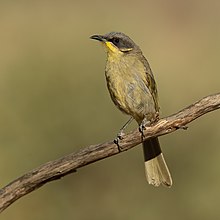Purple-gaped honeyeater
| Purple-gaped honeyeater | |
|---|---|

| |
| Scientific classification | |
| Domain: | Eukaryota |
| Kingdom: | Animalia |
| Phylum: | Chordata |
| Class: | Aves |
| Order: | Passeriformes |
| Family: | Meliphagidae |
| Genus: | Lichenostomus |
| Species: | L. cratitius
|
| Binomial name | |
| Lichenostomus cratitius (Gould, 1841)
| |
| Subspecies | |
| |

| |
| Distribution of the purple-gaped honeyeater | |
The purple-gaped honeyeater (Lichenostomus cratitius) is a species of
Description
The purple-gaped honeyeater is a medium-sized (16-19 centimetres) honeyeater which is generally grey-olive above and buffish yellow below.[3] They have a patterned head, with a black eyestripe against a grey background and purple gape above a yellow streak on the throat and pointed yellow ear coverts.[3] Juveniles are similar, but with duller facial patterns, slightly browner plumage, and a yellow gape and gape line.[2] The Kangaroo Island subspecies is considered to be larger and darker than the mainland subspecies.[2]
Similar species include yellow-plumed honeyeater and singing honeyeater.[4]
Call
The song is a clear toweet-toweet-toweet, followed by a high-pitched yep-yep-yep, often performed from a tall branch, including before dawn.[2][4]
Distribution
They occur in disjunct populations across southern Australia, east from southern Western Australia, with the eastern population largely occurring south of the Murray River, and NSW forming the extreme north-east of its range.[3] Despite its naturally disjunct populations, the purple-gaped honeyeater has very low genetic diversity across its range.[5]
Ecology and behaviour
The main habitat type for purple-gaped honeyeater is mallee woodland and shrubland.[4] This includes bull mallee, with patches of green mallee or blue mallee.[4] They also occur in yellow gum woodland with dense thickets of 'totem-poles' or violet honey-myrtle on low-lying flats and gullies in mallee areas.[4] They are occasionally recorded in river red gums bordering waterways,[3] and seasonally in red ironbark woodlands when they are in flower.[4] Purple-gaped honeyeaters can also occasionally be found in gardens.[2]
They are gregarious, usually seen in pairs, or groups of 3-8 birds.[4] Generally considered quiet and unobtrusive, except in spring when they may call often.[4] They are known to regularly drink and bathe, particularly in warmer weather.[4] Purple-gaped honeyeaters associate with yellow-plumed honeyeater and tawny-crowned honeyeater,[4] but can be aggressive towards other honeyeaters,[2] and frequently chase other birds, particularly when feeding.[3]
Diet
Purple-gaped honeyeaters feed mainly on nectar and insects,[2] especially from flowering mallee eucalypts,[4] and banksias.[3] They also forage for insects under loose bark on trunks and branches of trees, or catch flying insects on the wing.[4][3] Seeds, pollen and honeydew from scale insects are less frequently consumed.[3]
Reproduction
Purple-gaped honeyeaters build nests as a small cup of bark strips, grass and down, bound with spider web and egg sacs, slung in a horizontal fork or from slender branchlets within dense foliage (usually broombush or eucalypts), normally less than three metres above the ground.[3]
Threats
The purple-gaped honeyeater is vulnerable to clearing of mallee, which destroys habitat by removing food plants and nesting sites.[3]
Conservation actions
Conservation status
- Internationally
- * The species is listed under the IUCN Red List of Threatened Species as a species of 'Least concern'.[1]
- Australia
- * In NSW, it is listed as Vulnerable under the Biodiversity Conservation Act 2016.[3]
- * In South Australia, the species is listed as Rare under the National Parks and Wildlife Act 1972.[6]
- * In Victoria, the species is listed as Vulnerable under the Flora and Fauna Guarantee Act 1988.[7]
Protected areas
Purple-gaped honeyeaters occur in several protected areas, including:
- New South Wales
- South Australia
- * Flinders Chase National Park[8]
- * Gawler Ranges National Park[9]
- * Billiatt Conservation Park[10]
- * Peebinga Conservation Park[11]
- * Gluepot Reserve[12]
- Victoria
- * Greater Bendigo National Park[4]
- * Hattah-Kulkyne National Park[13]
- * Little Desert National Park[13]
- * Murray-Sunset National Park[13]
- * Wyperfeld National Park[13]
- * Big Desert Wilderness Park[13]
- * Lake Albacutya Park[13]
- * Inglewood Nature Conservation Reserve[4]
- * Wychitella Nature Conservation Reserve[4]
- Western Australia
References
- ^ . Retrieved 12 November 2021.
- ^ ISBN 9781486311934
- ^ a b c d e f g h i j k l "Purple-gaped Honeyeater - profile". NSW Office of Environment & Heritage. Retrieved 6 June 2022.
- ^ ISBN 9781486313150
- doi:10.1071/ZO20074.
- ^ "National Parks and Wildlife Act 1972" (PDF) (PDF). Department for Environment and Water (South Australia). March 2021. Retrieved 7 June 2022.
- ^ "Flora and Fauna Guarantee Act 1988 - Threatened List" (PDF) (PDF). Department of Environment, Land, Water and Planning. June 2021. Retrieved 7 June 2022.
- .
- ^ "Important Bird Areas factsheet: Gawler Ranges". BirdLife International. 2016. Retrieved 7 June 2022.
- ^ "Important Bird Areas factsheet: Billiatt". BirdLife International. 2009. Retrieved 7 June 2022.
- ^ "Important Bird Areas factsheet: Peebinga". BirdLife International. Retrieved 7 June 2022.
- Birdlife Australia. April 2016. Retrieved 7 June 2022.
- ^ a b c d e f "Factsheet - Birds of the Mallee Parks" (PDF). Parks Victoria (PDF). Victoria State Government. May 2019. Retrieved 7 June 2022.
- ^ "Mt Ragged Campground". Parks and Wildlife Service (PDF). Department of Biodiversity, Conservation and Attractions (Western Australia). 2017. Retrieved 7 June 2022.
- ^ "Cape Le Grand National Park Bird Checklist". Avibase. Retrieved 8 June 2022.

